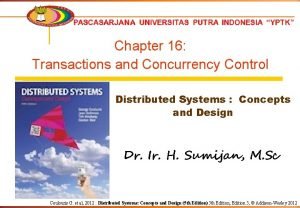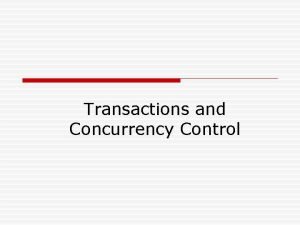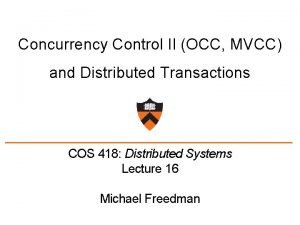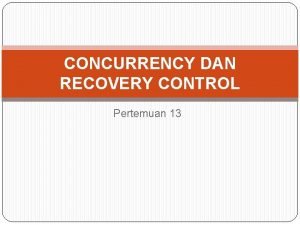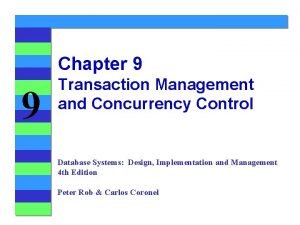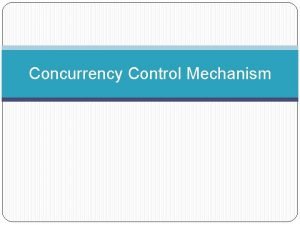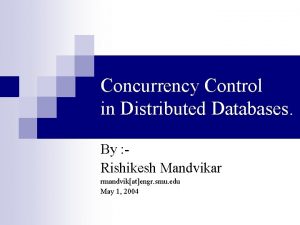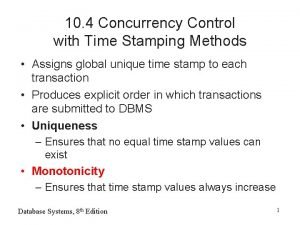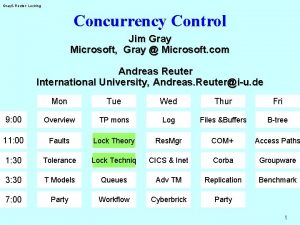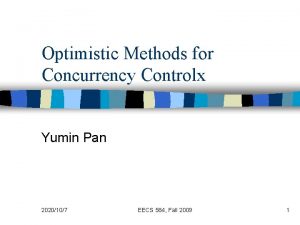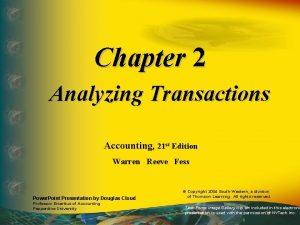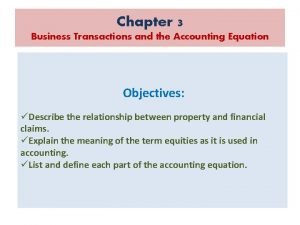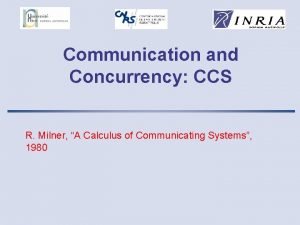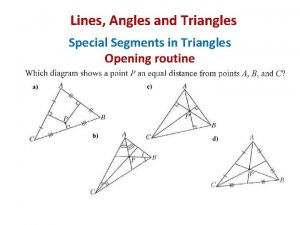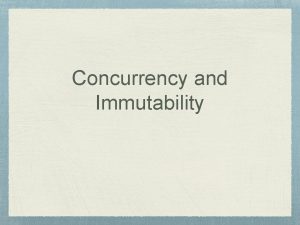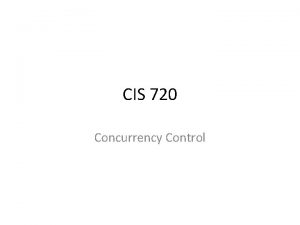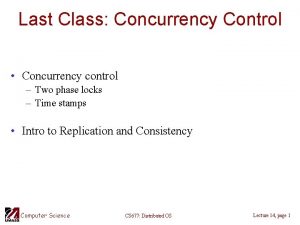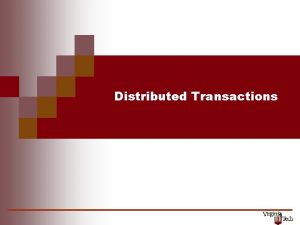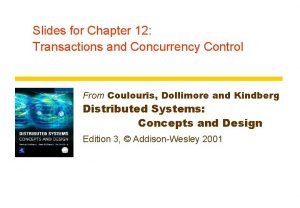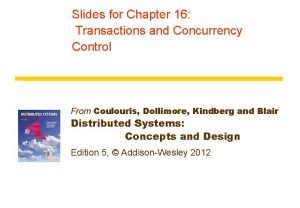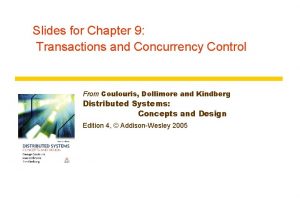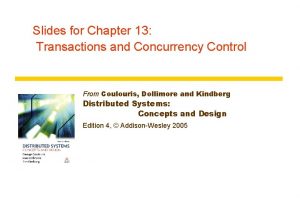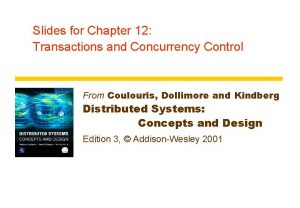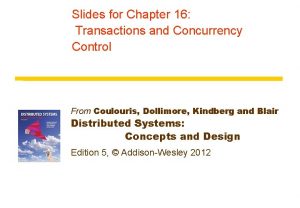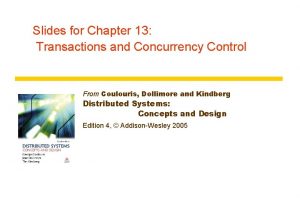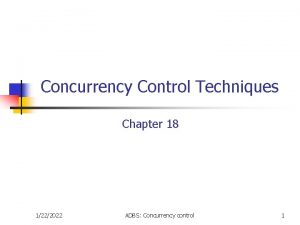Exercises for Chapter 16 Transactions and Concurrency Control



























- Slides: 27

Exercises for Chapter 16: Transactions and Concurrency Control From Coulouris, Dollimore and Kindberg Distributed Systems: Concepts and Design Edition 4, © Pearson Education 2005

Exercise 13. 1 z The Task. Bag is a service whose functionality is to provide a repository for ‘task descriptions’. It enables clients running in several computers to carry out parts of a computation in parallel. A master process places descriptions of sub-tasks of a computation in the Task. Bag, and worker processes select tasks from the Task. Bag and carry them out, returning descriptions of results to the Task. Bag. The master then collects the results and combines them to produce the final result. The Task. Bag service provides the following operations: set. Task take. Task allows clients to add task descriptions to the bag; allows clients to take task descriptions out of the bag. A client makes the request take. Task, when a task is not available but may be available soon. Discuss the advantages and drawbacks of the following alternatives: (i) the server can reply immediately, telling the client to try again later; (ii) make the server operation (and therefore the client) wait until a task becomes available. (iii)use callbacks. . Instructor’s Guide for Coulouris, Dollimore and Kindberg Distributed Systems: Concepts and Design Edn. 4 © Pearson Education 2005

Exercise 13. 2 z A server manages the objects a 1, a 2, . . . an. The server provides two operations for its clients: read (i) returns the value of ai; write(i, Value) assigns Value to ai. The transactions T and U are defined as follows: T: x = read(j); y = read (i); write(j, 44); write(i, 33); U: x = read(k); write(i, 55); y = read (j); write(k, 66). Give three serially equivalent interleavings of the transactions T and U. Instructor’s Guide for Coulouris, Dollimore and Kindberg Distributed Systems: Concepts and Design Edn. 4 © Pearson Education 2005

Exercise 13. 3 z Give serially equivalent interleavings of T and U in Exercise 13. 2 with the following properties: (1) that is strict; (2) that is not strict but could not produce cascading aborts; (3) that could produce cascading aborts. page 479 Instructor’s Guide for Coulouris, Dollimore and Kindberg Distributed Systems: Concepts and Design Edn. 4 © Pearson Education 2005

Exercise 13. 4 z The operation create inserts a new bank account at a branch. The transactions T and U are defined as follows: T: a. Branch. create("Z"); U: z. deposit(10); z. deposit(20). Assume that Z does not yet exist. Assume also that the deposit operation does nothing if the account given as argument does not exist. Consider the following interleaving of transactions T and U: T U z. deposit(10); a. Branch. create(Z); z. deposit(20); State the balance of Z after their execution in this order. Are these consistent with serially equivalent executions of T and U? Instructor’s Guide for Coulouris, Dollimore and Kindberg Distributed Systems: Concepts and Design Edn. 4 © Pearson Education 2005

Exercise 13. 5 z A newly created object like Z in Exercise 13. 4 is sometimes called a phantom. From the point of view of transaction U, Z is not there at first and then appears (like a ghost). Explain, with an example, how a phantom could occur when an account is deleted. Instructor’s Guide for Coulouris, Dollimore and Kindberg Distributed Systems: Concepts and Design Edn. 4 © Pearson Education 2005

Exercise 13. 6 z The ‘transfer’ transactions T and U are defined as: T: a. withdraw(4); b. deposit(4); U: c. withdraw(3); b. deposit(3); Suppose that they are structured as pairs of nested transactions: T 1: a. withdraw(4); T 2: b. deposit(4); U 1: c. withdraw(3); U 2: b. deposit(3); Compare the number of serially equivalent interleavings of T 1, T 2, U 1 and U 2 with the number of serially equivalent interleavings of T and U. Explain why the use of these nested transactions generally permits a larger number of serially equivalent interleavings than non-nested ones. Instructor’s Guide for Coulouris, Dollimore and Kindberg Distributed Systems: Concepts and Design Edn. 4 © Pearson Education 2005

Exercise 13. 7 z Consider the recovery aspects of the nested transactions defined in Exercise 13. 6. Assume that a withdraw transaction will abort if the account will be overdrawn and that in this case the parent transaction will also abort. Describe serially equivalent interleavings of T 1, T 2, U 1 and U 2 with the following properties: (i) that is strict; (ii) that is not strict. To what extent does the criterion of strictness reduce the potential concurrency gain of nested transactions? Instructor’s Guide for Coulouris, Dollimore and Kindberg Distributed Systems: Concepts and Design Edn. 4 © Pearson Education 2005

Exercise 13. 8 z Explain why serial equivalence requires that once a transaction has released a lock on an object, it is not allowed to obtain any more locks. A server manages the objects a 1, a 2, . . . an. The server provides two operations for its clients: read(i) returns the value of ai write(i, Value) assigns Value to ai The transactions T and U are defined as follows: T: x = read(i); write(j, 44); U: write(i, 55); write(j, 66); Describe an interleaving of the transactions T and U in which locks are released early with the effect that the interleaving is not serially equivalent. Instructor’s Guide for Coulouris, Dollimore and Kindberg Distributed Systems: Concepts and Design Edn. 4 © Pearson Education 2005

Exercise 13. 9 (part 1) z The transactions T and U at the server in Exercise 13. 8 are defined as follows: T: x = read(i); write(j, 44); U: write(i, 55); write(j, 66); Initial values of ai and aj are 10 and 20, respectively. Which of the following interleavings are serially equivalent, and which could occur with two-phase locking? a) T U b) T U x = read (i); write(i, 55); write(j, 44); write(i, 55); write(j, 66); Instructor’s Guide for Coulouris, Dollimore and Kindberg Distributed Systems: Concepts and Design Edn. 4 © Pearson Education 2005

Exercise 13. 9 continued (c) T U write(i, 55); write(j, 66); (d) T x = read (i); write(j, 66); x = read (i); write(j, 44); U write(i, 55); write(j, 44); Instructor’s Guide for Coulouris, Dollimore and Kindberg Distributed Systems: Concepts and Design Edn. 4 © Pearson Education 2005

Exercise 13. 10 z Consider a relaxation of two-phase locks in which read-only transactions can release read locks early. Would a read-only transaction have consistent retrievals? Would the objects become inconsistent? Illustrate your answer with the following transactions T and U at the server in Exercise 13. 8: T: x = read (i); y= read(j); U: write(i, 55); write(j, 66); in which initial values of ai and aj are 10 and 20. Instructor’s Guide for Coulouris, Dollimore and Kindberg Distributed Systems: Concepts and Design Edn. 4 © Pearson Education 2005

Exercise 13. 11 z The executions of transactions are strict if read and write operations on an object are delayed until all transactions that previously wrote that object have either committed or aborted. Explain how the locking rules in Figure 13. 16 ensure strict executions. Instructor’s Guide for Coulouris, Dollimore and Kindberg Distributed Systems: Concepts and Design Edn. 4 © Pearson Education 2005

Exercise 13. 12 z Describe how a non-recoverable situation could arise if write locks are released after the last operation of a transaction but before its commitment. Instructor’s Guide for Coulouris, Dollimore and Kindberg Distributed Systems: Concepts and Design Edn. 4 © Pearson Education 2005

Exercise 13. 13 z Explain why executions are always strict, even if read locks are released after the last operation of a transaction but before its commitment. Give an improved statement of rule 2 in Figure 13. 16. Instructor’s Guide for Coulouris, Dollimore and Kindberg Distributed Systems: Concepts and Design Edn. 4 © Pearson Education 2005

Exercise 13. 14 (first part) z Consider a deadlock detection scheme for a single server. Describe precisely when edges are added to and removed from the wait-for-graph. Illustrate your answer with respect to the following transactions T, U and V at the server of Exercise 13. 8 T U write(i, 66); V write(i, 55); write(i, 77); commit Instructor’s Guide for Coulouris, Dollimore and Kindberg Distributed Systems: Concepts and Design Edn. 4 © Pearson Education 2005

Exercise 13. 14 continued z When U releases its write lock on ai, both T and V are waiting to obtain write locks on it. Does your scheme work correctly if T (first come) is granted the lock before V? If your answer is ‘No’, then modify your description. Instructor’s Guide for Coulouris, Dollimore and Kindberg Distributed Systems: Concepts and Design Edn. 4 © Pearson Education 2005

Exercise 13. 15 z Consider hierarchic locks as illustrated in Figure 13. 26. What locks must be set when an appointment is assigned to a time slot in week w, day d, at time t? In what order should these locks be set? Does the order in which they are released matter? What locks must be set when the time slots for every day in week w are viewed? Can this be done when the locks for assigning an appointment to a time slot are already set? Instructor’s Guide for Coulouris, Dollimore and Kindberg Distributed Systems: Concepts and Design Edn. 4 © Pearson Education 2005

Exercise 13. 16 z Consider optimistic concurrency control as applied to the transactions T and U defined in Exercise 13. 9. Suppose that transactions T and U are active at the same time as one another. Describe the outcome in each of the following cases: (i) T's request to commit comes first and backward validation is used; (ii) U's request to commit comes first and backward validation is used; (iii) T's request to commit comes first and forward validation is used; (iv) U's request to commit comes first and forward validation is used. In each case describe the sequence in which the operations of T and U are performed, remembering that writes are not carried out until after validation. Instructor’s Guide for Coulouris, Dollimore and Kindberg Distributed Systems: Concepts and Design Edn. 4 © Pearson Education 2005

Exercise 13. 17 z Consider the following interleaving of transactions T and U: T U open. Transaction y = read(k); write(i, 55); write(j, 66); commit y = read(i); write(j, 44); The outcome of optimistic concurrency control with backward validation is that T will be aborted because its read operation conflicts with U's write operation on ai, although the interleavings are serially equivalent. Suggest a modification to the algorithm that deals with such cases. Instructor’s Guide for Coulouris, Dollimore and Kindberg Distributed Systems: Concepts and Design Edn. 4 © Pearson Education 2005

Exercise 13. 18 z Make a comparison of the sequences of operations of the transactions T and U of Exercise 13. 8 that are possible under two-phase locking (Exercise 13. 9) and under optimistic concurrency control (Exercise 13. 16). T: x = read(i); write(j, 44); U: write(i, 55); write(j, 66); Instructor’s Guide for Coulouris, Dollimore and Kindberg Distributed Systems: Concepts and Design Edn. 4 © Pearson Education 2005

Exercise 13. 19 z Consider the use of timestamp ordering with each of the example interleavings of transactions T and U in Exercise 13. 9. Initial values of ai and aj are 10 and 20, respectively, and initial read and write timestamps are t 0. Assume that each transaction opens and obtains a timestamp just before its first operation; for example, in (a) T and U get timestamps t 1 and t 2 respectively, where t 0 < t 1 < t 2. Describe in order of increasing time the effects of each operation of T and U. For each operation, state the following: (i) whether the operation may proceed according to the write or read rule; (ii)timestamps assigned to transactions or objects; (iii) creation of tentative objects and their values. What are the final values of the objects and their timestamps? Instructor’s Guide for Coulouris, Dollimore and Kindberg Distributed Systems: Concepts and Design Edn. 4 © Pearson Education 2005

Exercise 13. 20 z Repeat Exercise 13. 19 for the following interleavings of transactions T and U T U open. Transaction write(i, 55); write(j, 66); commit x = read (i); write(j, 44); Instructor’s Guide for Coulouris, Dollimore and Kindberg Distributed Systems: Concepts and Design Edn. 4 © Pearson Education 2005

Exercise 13. 21 z Repeat Exercise 13. 20 using multiversion timestamp ordering. Instructor’s Guide for Coulouris, Dollimore and Kindberg Distributed Systems: Concepts and Design Edn. 4 © Pearson Education 2005

Exercise 13. 22 z In multiversion timestamp ordering, read operations can access tentative versions of objects. Give an example to show cascading aborts can happen if all read operations are allowed to proceed immediately. Instructor’s Guide for Coulouris, Dollimore and Kindberg Distributed Systems: Concepts and Design Edn. 4 © Pearson Education 2005

Exercise 13. 23 z What are the advantages and drawbacks of multiversion timestamp ordering in comparison with ordinary timestamp ordering. Instructor’s Guide for Coulouris, Dollimore and Kindberg Distributed Systems: Concepts and Design Edn. 4 © Pearson Education 2005

Exercise 13. 24 z Make a comparison of the sequences of operations of the transactions T and U of Exercise 13. 8 that are possible under two-phase locking (Exercise 13. 9) and under optimistic concurrency control (Exercise 13. 16) T: x = read(i); write(j, 44); U: write(i, 55); write(j, 66); Instructor’s Guide for Coulouris, Dollimore and Kindberg Distributed Systems: Concepts and Design Edn. 4 © Pearson Education 2005
 Transactions and concurrency control in distributed systems
Transactions and concurrency control in distributed systems Example of concurrency control in dbms
Example of concurrency control in dbms Concurrency control in distributed transactions
Concurrency control in distributed transactions Concurrency exercises
Concurrency exercises Pessimistic concurrency control
Pessimistic concurrency control Concurrency control adalah
Concurrency control adalah Transaction and concurrency control in dbms
Transaction and concurrency control in dbms Transaction management and concurrency control
Transaction management and concurrency control Pitfalls of lock based protocol
Pitfalls of lock based protocol Concurrency control in distributed databases
Concurrency control in distributed databases Concurrency control with time stamping methods
Concurrency control with time stamping methods Microsoft flow concurrency control
Microsoft flow concurrency control Timestamp based concurrency control
Timestamp based concurrency control On optimistic methods for concurrency control
On optimistic methods for concurrency control Analyzing accounting concepts and practices chapter 2
Analyzing accounting concepts and practices chapter 2 Analyzing transactions in a cash control system
Analyzing transactions in a cash control system Accounting equation exercises
Accounting equation exercises Communication and concurrency
Communication and concurrency Safety and liveness in concurrency
Safety and liveness in concurrency Special segments in triangles worksheet
Special segments in triangles worksheet Formuö
Formuö Novell typiska drag
Novell typiska drag Tack för att ni lyssnade bild
Tack för att ni lyssnade bild Returpilarna
Returpilarna Varför kallas perioden 1918-1939 för mellankrigstiden
Varför kallas perioden 1918-1939 för mellankrigstiden En lathund för arbete med kontinuitetshantering
En lathund för arbete med kontinuitetshantering Personalliggare bygg undantag
Personalliggare bygg undantag Tidbok för yrkesförare
Tidbok för yrkesförare
